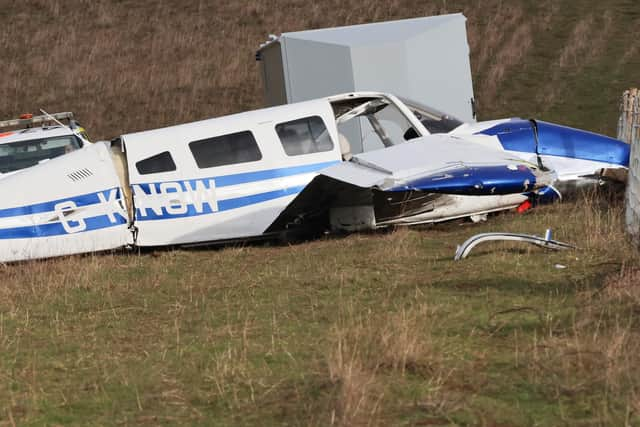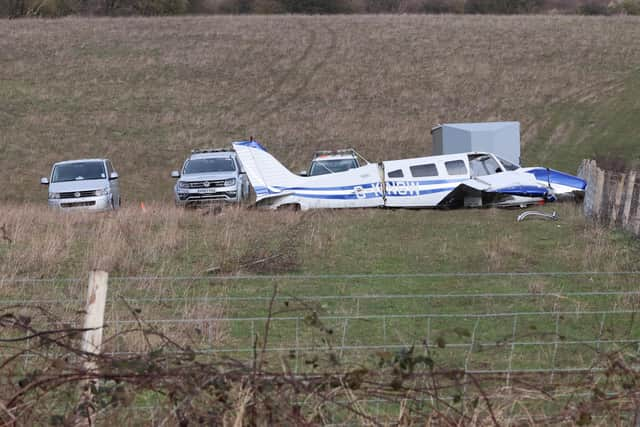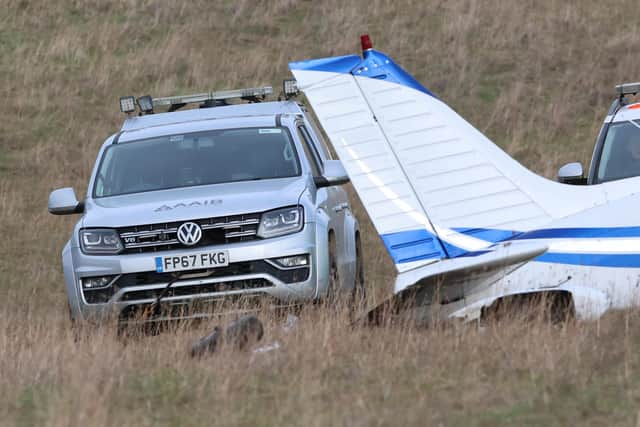Sussex plane crash: Inspectors reveal what caused incident that left two seriously injured on the Downs
and live on Freeview channel 276
Firefighters and paramedics were called to a plane crash on the Downs near Steyning around 1pm on Friday, February 11.
The Piper PA-32-300, G-KNOW plane had crashed on open downland – at Steyning Valley, South Downs Way – and the two occupants suffered serious injuries.
Advertisement
Hide AdAdvertisement
Hide AdA report by the UK Government’s Air Accidents Investigation Branch (AAIB) has been published today (Thursday, June 1).


The summary read: “While the aircraft had sufficient fuel on board for the flight, the fuel tank being used – which was one of four, separate, manually selected tanks – ran out of useable fuel, causing the engine to stop over a hilly area.
"Relevant emergency checklists were not carried out. The aircraft struck the ground heavily causing serious injuries to both occupants.
“In response to this accident, the CAA intends to include fuel management awareness in its current safety promotional activities.”
Advertisement
Hide AdAdvertisement
Hide AdThe AAIB report noted that the private aircraft landed on an eastern face of Steyning Valley. The passenger sustained serious injuries to his chest, spine and skull, whilst the pilot sustained serious and, ‘in some cases’, life-changing injuries to his head, neck, spine, chest and hips.


The aircraft, meanwhile, sustained ‘significant damage’ to its fuselage, wings, engine and propeller which were ‘beyond economic repair’.
The commander of the flight was 63-years-old and had 698 hours of flying experience – ‘of which 180 were on type’.
The report read: “On the day of the accident the pilot and a passenger set out to fly from Lydd Airport to Lee‑on-Solent Airport, and back. The accident occurred during the return flight. Aftercast information showed there was ‘little or no cloud’ near the aircraft route.
Advertisement
Hide AdAdvertisement
Hide Ad“The passenger, who could not fully recall the accident, reported believing they went inland to see a landmark. Recorded data indicated that at 12.58 the aircraft was heading east approaching Steyning on the northern border of the South Downs National Park, at 2,100 ft amsl and 136 KTAS.


“The passenger recalled the pilot saying they had ‘a problem’ and the aircraft lost engine power. The pilot turned the aircraft right onto a south-westerly heading. Although he could not recall the accident, he believed this was to face into wind and avoid a built-up area ahead.
"He transmitted a mayday call to Brighton City Airport, which was approximately four nautical miles to the south-east.”
The passenger – ‘who was not a pilot’ – heard the pilot talking through his actions ‘though could not recall what he said’, the AAIB report noted.
Advertisement
Hide AdAdvertisement
Hide AdIt added: "He recalled the pilot trying to restart the engine around two or three times and operating the engine control levers, especially the mixture control lever.
"A number of witnesses reported hearing the engine ‘revving’ and ‘spluttering’, before it stopped.”
The aircraft ‘glided towards’ Steyning Valley before turning left, descending south along its western ridge line – reaching a minimum height above it of around 160 ft. The aircraft turned left towards the rising ground on the opposite side of the valley, already below its ridge line.
The passenger described that turn as ‘ahead to the right were trees and ahead to the left was hilly grass’, adding: “There were a few bad options, it was trying to decide which was least bad, the trees, or where we ended up on the hill.”
Advertisement
Hide AdAdvertisement
Hide AdThe aircraft’s TAS reduced throughout the descent to 67 kt, with a ‘corresponding rate of descent of around 650 ft/min’. The passenger indicated the ground was ‘possibly steeper than it looked’, and the aircraft struck it ‘hard’, seriously injuring both occupants.
The AAIB added: “A helicopter emergency medical services (HEMS) crew heard the emergency on Brighton City’s radio frequency and routed to the accident site.
"The HEMS crew and some witnesses helped the passenger exit the aircraft and extricated the pilot, who was unconscious. Both occupants were airlifted to hospital.”
According to the report, the passenger recalled the pilot had inspected the fuel tank quantities – both visually and on the gauges – checking fuel samples, before both flights. The pilot performed engine ground checks ‘without any apparent abnormalities’.
Advertisement
Hide AdAdvertisement
Hide Ad"The passenger said the pilot explained some technical aspects to him prior to the outbound flight, including using the fuel selector lever to switch between tanks regularly.
"He recalled the pilot operating that lever during the flights but could not recall when. He did not remember noticing any fuel alarms which may have occurred.
"The passenger described that after the engine stopped, the pilot “was occupied with re-starting the engine, then the mayday call, then the heading we were given, then figuring out if we could make it, and then when we realised we wouldn’t, where best to set the aircraft down.
"A number of eye witnesses indicated that after the accident there was a strong smell of fuel near the aircraft, and it was trickling from a wing tip.”
Advertisement
Hide AdAdvertisement
Hide AdIn conclusion, inspectors found that the aircraft’s engine stopped because the fuel tank being used ‘ran out of useable fuel’, adding: “There was sufficient fuel in the remaining three tanks to complete the flight.
"Relevant emergency checklists were not carried out and the aircraft struck hilly ground.
“Proper fuel management, especially on aircraft with multiple fuel tanks, and regularly self-briefing emergency procedures in a threat and error management context could reduce the risk of, or consequences of, engine stoppage due to fuel starvation.”